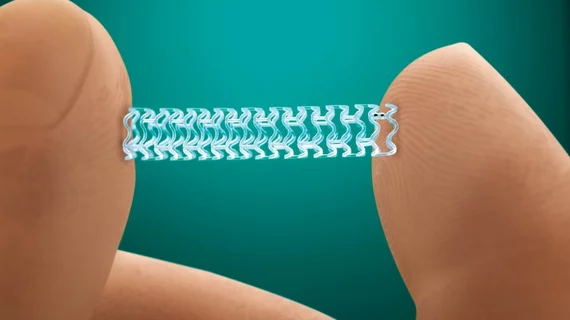A press conference at the 2018 Transcatheter Cardiovascular Therapeutics meeting in San Diego on Tuesday, Sept. 25, morphed into a discussion about the future of bioresorbable vascular scaffolds (BVS) and whether it’s worth pursuing bioresorbable stent technology at all.
The comments stemmed from the presentations of one-year results from ABSORB IV and COMPARE-ABSORB, both of which found Abbott’s Absorb BVS was statistically noninferior to the company’s Xience drug-eluting stent (DES) for the primary endpoint of target-lesion failure (TLF). However, the BVS in both cases was linked to more cases of TLF (7.8 percent versus 6.4 percent in ABSORB IV; 5.1 percent versus 4.2 percent in COMPARE-ABSORB) and device thrombosis (0.7 percent vs. 0.3 percent in ABSORB IV; 2.0 versus 0.6 percent in COMPARE-ABSORB).
The Absorb stents were pulled from the commercial market last year but researchers are still interested in following the long-term outcomes associated with the devices because the bioresorbable properties of the stents were designed to improve outcomes especially after three years—once the scaffolds fully dissolve. Gregg W. Stone, MD, who presented the ABSORB IV results, also presented four-year results from earlier Absorb-related studied at TCT. He said both BVS and DES had equal risk of target lesion failure between years 3 and 4, but stent thrombosis was 0.2 percent for Xience and 0.1 percent for BVS during that timeframe, suggesting “something appears to have flipped” regarding long-term benefit.
“I think (long-term follow-up) is important because I think we need some proof that there’s a light at the end of the tunnel,” said David J. Cohen, MD, director of cardiovascular research at Saint Luke’s Mid America Heart Institute in Kansas City, Missouri. “There is this early penalty with respect to scaffold thrombosis and procedural-related MI, and the benefit is all promise. It’s hard to sell promise; it’s hard to do something for a promise that so far we have absolutely no evidence that it’s realized.”
Still, Cohen and other cardiologists who commented to the press agreed bioresorbable stents are pursuing a worthy goal. They were designed to prevent late TLF, which occur at a reported rate of 2 to 3 percent per year for a patient’s lifetime.
“There’s probably general agreement here that there are late events that would be nice to avoid,” Cohen said. “If this is an approach that can be proven to do that, then it would be worth pursuing and promoting.
“The challenge just is, is how long do you have to wait? Many of our patients don’t have 10- or 15-year life expectancies so what’s the point there? And then for technology, you can pretty much bet that if we do show at seven years in ABSORB-COMPARE or at 10 years in ABSORB IV that there’s a benefit of the BVS versus the metallic DES, by then we’ll have completely different metallic DES and we won’t really know if it was really better.”
Stone mentioned other companies are developing thinner-strut BVS, which could mitigate one of the proposed weaknesses of the earlier devices.
“The biggest liability is probably strut thickness, secondarily is probably strut width, third is radial force with expansion characteristics—the width and how wide you can expand it before there’s a fracture risk,” he said.
With current-generation DES already generating strong results, Renu Virmani, MD, said she questioned whether BVS deserved a spot in the marketplace unless the technology “enormously” improves in terms of safety and efficacy.
“I personally think that because they don’t have the strength, fracture is a real problem,” she said.
Stone noted during his ABSORB IV presentation that TLF curves were parallel between the BVS and DES from 30 days to one year. The excess events for the Absorb stents were driven completely by outcomes in the first month.
“That this all happened so early makes me really concerned about the technique,” said Azeem Latib, MBBCh, with the San Raffaele Scientific Institute in Milan. “For BVS to (work), it’s really going to require scaffolds that are much easier to implant than these first-generation ones.”

